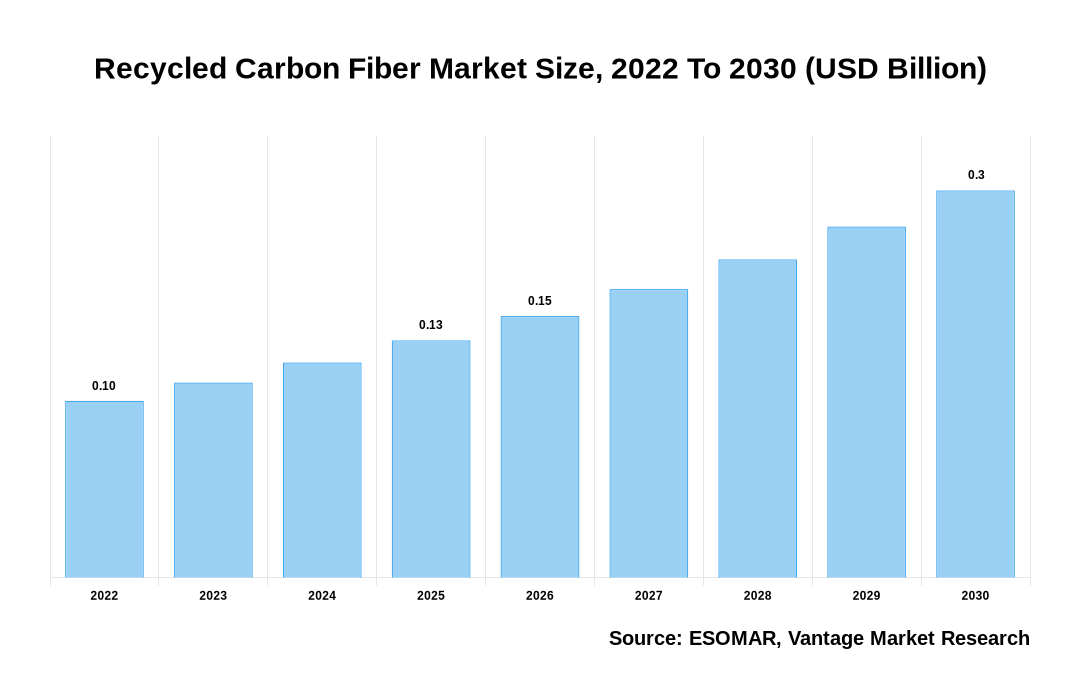Global Recycled Carbon Fiber Market
As stated in our extensive report, the Global Recycled Carbon Fiber Market accounted for USD 0.1 Billion in 2022 and is projected to reach a value of USD 0.3 Billion by 2030.
Carbon fiber recycling is reclaiming fibers from carbon fiber-reinforced composites (CFRC). There are two kinds of carbon fiber waste. The first waste is virgin carbon fiber offcuts from dry fiber and non-used expired material, often known as scrap. Recycled Carbon Fiber creates new, high-performance parts in various end-use industries, including building and construction, aerospace and defense, automotive and transportation, etc.
Rapid urbanization has occurred in developed and emerging economies, including the United States, China, and India. This has increased government spending on the building and construction sectors to establish prospective infrastructure projects. According to research released by the National Investment Promotion and Facilitation Agency, infrastructure operations would account for 13% of total foreign direct investment (FDI) inflows in 2021. Furthermore, the rapid development of water supply, sanitation, urban transportation, schools, and healthcare assists the growth of the building and construction sector.
Click To Get a Free Sample On the Research Study

Furthermore, factors such as rising disposable income, technical advancements, and an increased number of original equipment manufacturers (OEMs) have significantly expanded the automotive and transportation sectors. Domestic automobile manufacturing increased at a compound annual growth rate (CAGR) of 2.36% from 2016 to 2020, with 26.36 million vehicles built in India in 2020, according to the India Brands Equity Foundation.
Key Factors Influencing Global Recycled Carbon Fiber Market Growth
The growth of the global Recycled Carbon Fiber market can be attributable to the following:
- Carbon fiber recycling helps to reduce carbon emissions and energy consumption related with the production of virgin carbon fiber. As governments and industries focus on environmental sustainability and circular economy initiatives, the demand for Recycled Carbon Fiber is expected to increase.
- Developing advanced recycling technologies for carbon fiber, such as pyrolysis and solvolysis, has made it possible to recover high-quality carbon fiber from waste materials. These technological advancements have improved the economics of recycling carbon fiber, making it a more viable option for industries.
- With the growth of industries consuming carbon fiber, such as aerospace and automotive, a significant amount of waste carbon fiber is generated during manufacturing processes. The availability of this waste carbon fiber as a feedstock for recycling has increased, driving the growth of the Recycled Carbon Fiber market.
- Governments throughout the world are enacting rules and funding efforts to promote material recycling and reuse. These regulations are expected to drive the adoption of Recycled Carbon Fiber in various industries, further boosting market growth.
- Recycled Carbon Fiber offers cost advantages over virgin carbon fiber, as it reduces the need for expensive raw materials and energy-intensive manufacturing processes. This cost advantage makes Recycled Carbon Fiber an attractive option for industries looking to reduce production costs.
North America Region to Express the Largest Market Growth
The North America Recycled Carbon Fiber market is expected to expand by 2022. The building and construction industry in the United States is quickly developing, raising demand for Recycled Carbon Fiber used in producing windows, door systems, external trim, decks, columns, fences, and pergolas. According to Census Bureau research, overall construction spending in May 2021 is expected to be $1,545.3 billion, a 7.5% rise over the May 2020 forecast of $1,437.7 billion.
Furthermore, the automotive sector in Canada is expanding rapidly, which may improve the performance of Recycled Carbon Fiber materials used to manufacture various automobile parts. According to Canadian government data, the country’s automotive and transportation sector increased by around 1.1% in 2019 compared to 2018, owing to rising imports and exports. Furthermore, significant automotive manufacturers have headquarters in this region, and favorable government rules aid in the product penetration of Recycled Carbon Fiber.
Conclusion
Overall, the Recycled Carbon Fiber market will likely expand rapidly in the coming years, owing to rising demand for lightweight and environmentally friendly materials, technological developments in recycling processes, and supporting government policies and initiatives.
Some of the key players in the Global Recycled Carbon Fiber Market include- Alpha Recyclage Composites (France), Carbon Conversions (U.S.), Carbon Fiber Recycling (Japan), Carbon Fiber Remanufacturing (U.S.), Gen 2 Carbon Limited (UK), Karborek RCF (Italy), Mitsubishi Chemical Holdings Corp. (Japan), Procotex (Belgium) and others.
![[Market Research Reports] – Research Google News Blog | VMR.Biz](https://www.vmr.biz/wp-content/uploads/2022/12/logo-removebg-preview.png)











